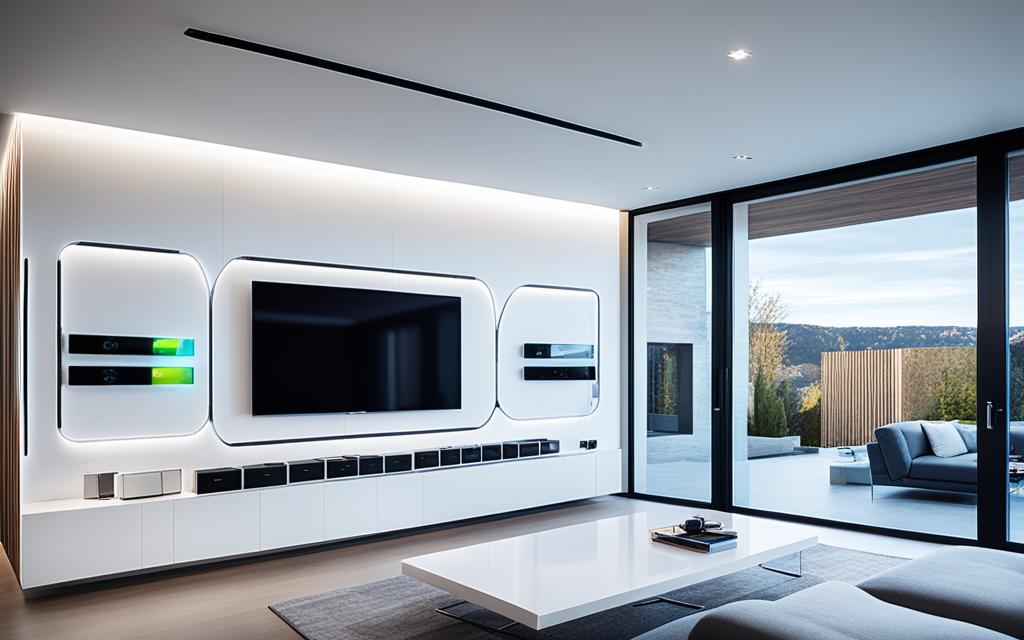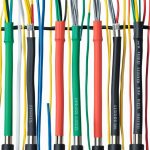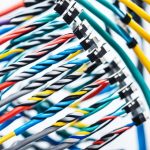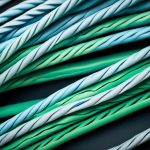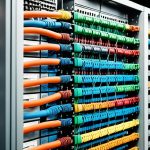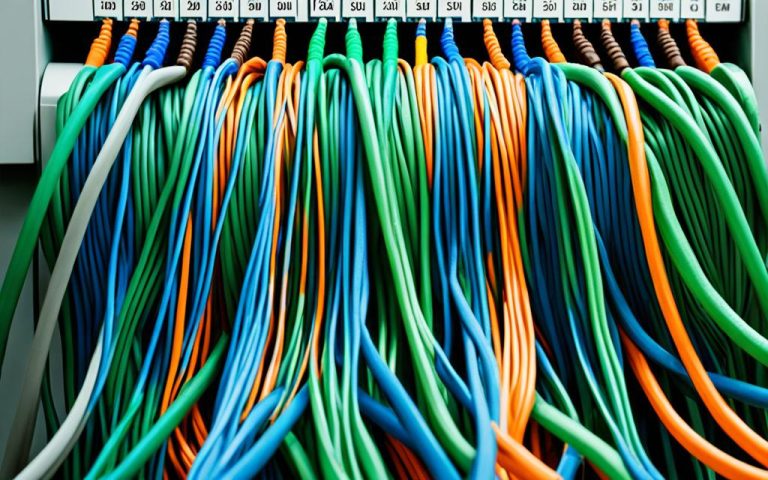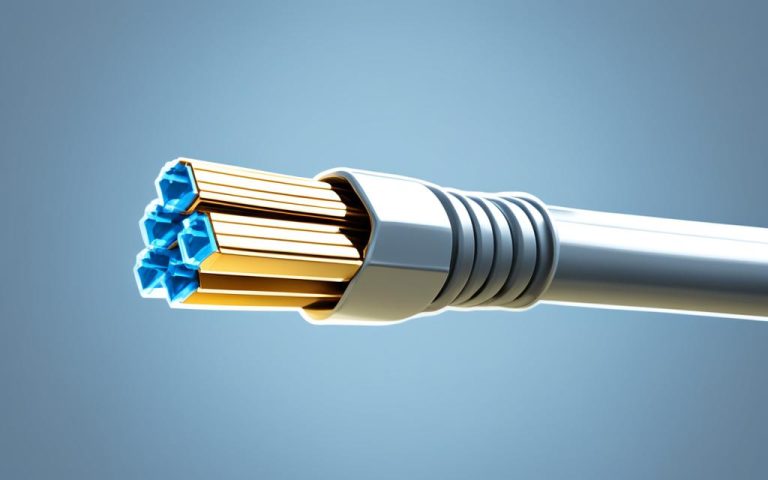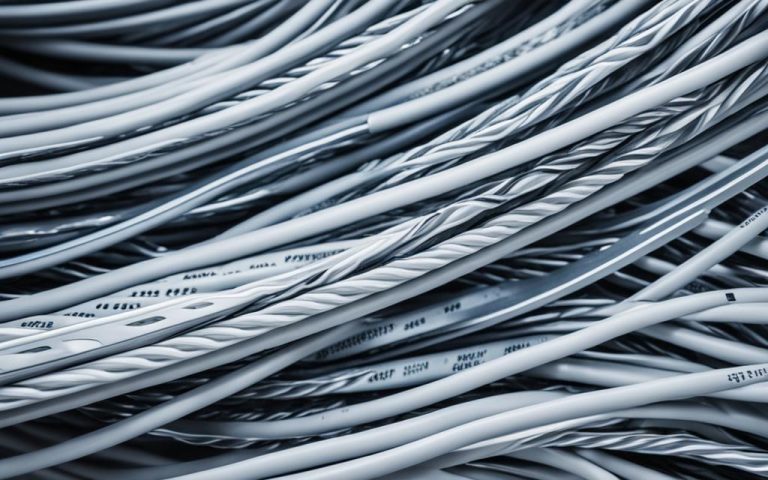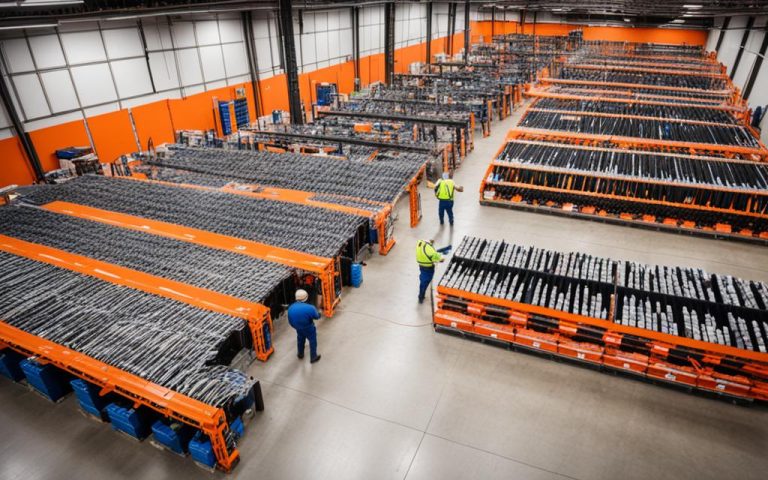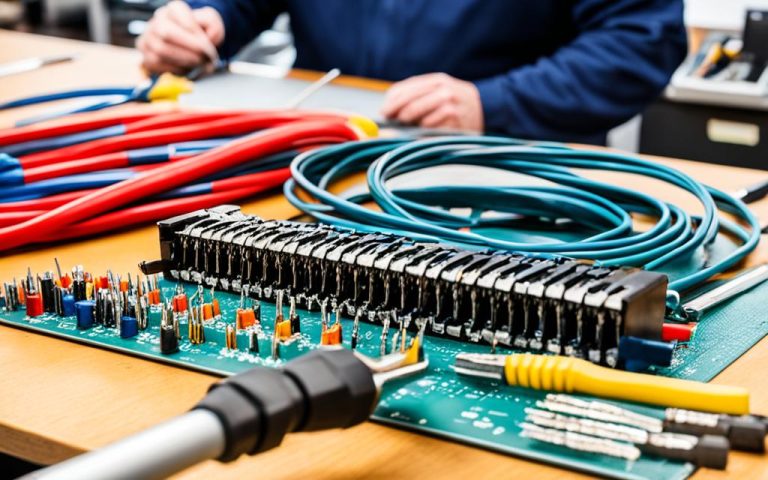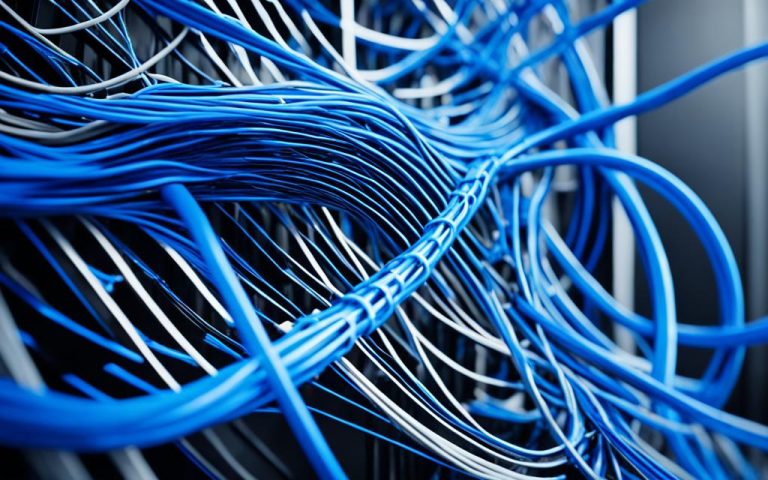Twisted Pair cabling, specifically CAT 7, plays a crucial role in ensuring reliable connectivity in smart homes. While the focus is often on the end components of smart technology, the importance of the cabling infrastructure cannot be overlooked.
CAT 7 cabling offers higher performance and durability compared to previous generations like CAT 5 and CAT 6. It provides a high-performance connection with a special double shielding and can handle up to 600 MHz. CAT 7 is more expensive but has a longer lifespan, making it a reliable and future-proof option for integrating smart home technologies.
By integrating Twisted Pair cabling, smart homes can achieve seamless communication between various devices, enabling the automation and control of functions such as temperature, motion, and audio. Whether it’s connecting temperature sensors or audio systems, CAT 7 cabling ensures reliable and fast connectivity in a smart home environment.
In the following sections, we will explore the differences between CAT 5, CAT 6, and CAT 7 cabling, the advantages of CAT 7 cabling for smart homes, and the integration of Twisted Pair cabling in smart home technologies. We will also compare wired and wireless smart home tech and discuss the pros and cons of both options.
Understanding the Differences Between CAT 5, CAT 6, and CAT 7
When it comes to Ethernet cabling, there are several options available, each with its own set of features and capabilities. Among the most popular choices are CAT 5, CAT 6, and CAT 7. Understanding the differences between these categories is essential for ensuring optimal performance and connectivity in your smart home.
CAT 5, which was the first Ethernet cabling used for computer networks, has now been deprecated since 2001. While it provided a reliable performance of up to 100 MHz, it lacked proper shielding, making it susceptible to interference. As technology advanced, the need for more robust cabling solutions arose.
CAT 6 was introduced to address the limitations of CAT 5. It brought improved specifications for reducing crosstalk and system noise, offering a higher performance threshold of up to 250 MHz. With enhanced shielding, CAT 6 cables provided increased reliability and faster data transmission speeds.
However, when it comes to integrating smart home technologies, CAT 7 is the ideal choice. This Gigabit Ethernet cable is specifically designed to meet the demands of modern smart homes. It boasts a performance capability of up to 600 MHz, allowing for even faster and more efficient data transfer. Additionally, CAT 7 cables feature special double shielding for their twisted pairs, providing enhanced durability and reliability in busy home environments.
Whether you’re streaming 4K content, connecting multiple smart devices, or engaging in online gaming, CAT 7’s superior performance and shielding capabilities make it the top choice for ensuring seamless connectivity in your smart home.
In summary, CAT 5, CAT 6, and CAT 7 offer varying levels of performance and reliability in Ethernet cabling. While CAT 5 is outdated and CAT 6 provides improved performance, CAT 7 is the ultimate choice for smart homes. Its higher MHz rating and double shielding make it the most durable and efficient option, allowing for seamless integration of smart devices in your home network.
Advantages of CAT 7 Twisted Pair Cabling for Smart Homes
CAT 7 twisted pair cabling offers numerous advantages for smart homes. Its superior design and shielding provide higher resistance and efficiency compared to CAT 6 and CAT 5 cables. These advantages make CAT 7 the ideal choice for integrating smart home technologies.
Enhanced Performance and Efficiency
CAT 7 cables are designed with a cross-section configuration and double shielding, enabling them to offer exceptional performance and efficiency. With a bandwidth of up to 600 MHz, CAT 7 cabling ensures a reliable and fast connection for various smart devices, including temperature sensors, motion sensors, and audio systems.
Unmatched Durability and Sturdiness
When it comes to durability, CAT 7 twisted pair cabling surpasses CAT 6 and CAT 5. Its robust construction and shielding make it highly resistant to interference and external factors. This durability ensures that the cabling can withstand the demands of a smart home environment, providing a stable and uninterrupted connection.
Longer Lifespan and Energy Efficiency
CAT 7 cables have a longer lifespan compared to their predecessors, CAT 6 and CAT 5. Investing in CAT 7 cabling ensures that your smart home network will remain reliable and future-proof for years to come. Additionally, CAT 7 cables are designed to be energy-efficient, contributing to a more sustainable and eco-friendly smart home setup.
By utilizing CAT 7 twisted pair cabling in your smart home, you can take advantage of these benefits to create a seamless and efficient smart technology experience.
| Advantages of CAT 7 Twisted Pair Cabling for Smart Homes |
|---|
| Enhanced performance and efficiency |
| Unmatched durability and sturdiness |
| Longer lifespan and energy efficiency |
Integration of Twisted Pair Cabling in Smart Home Technologies
Twisted Pair cabling, specifically CAT 7, is a vital component in the integration of smart home technologies. It plays a crucial role in connecting the sensor points in a smart home that control various functions such as temperature, motion, and audio. By providing a secure and stable connection, CAT 7 cabling ensures seamless communication between different smart devices and the central control system.
With its high bandwidth and durability, CAT 7 cabling is an ideal choice for the construction and expansion of smart homes. It offers reliable and fast connectivity, enabling smart devices to work together harmoniously. Whether it’s a smart thermostat adjusting the temperature, motion sensors triggering security alerts, or audio systems creating a immersive entertainment experience, the integration of Twisted Pair cabling ensures a smooth operation of smart home technologies.
“Twisted Pair cabling is like the backbone of a smart home. It connects all the essential points, allowing them to work together seamlessly.” – Alex Thompson, Smart Home Expert
Integrating Twisted Pair cabling in smart home technologies not only enhances the overall performance and reliability of the system but also opens up opportunities for future expansion and integration with emerging technologies.
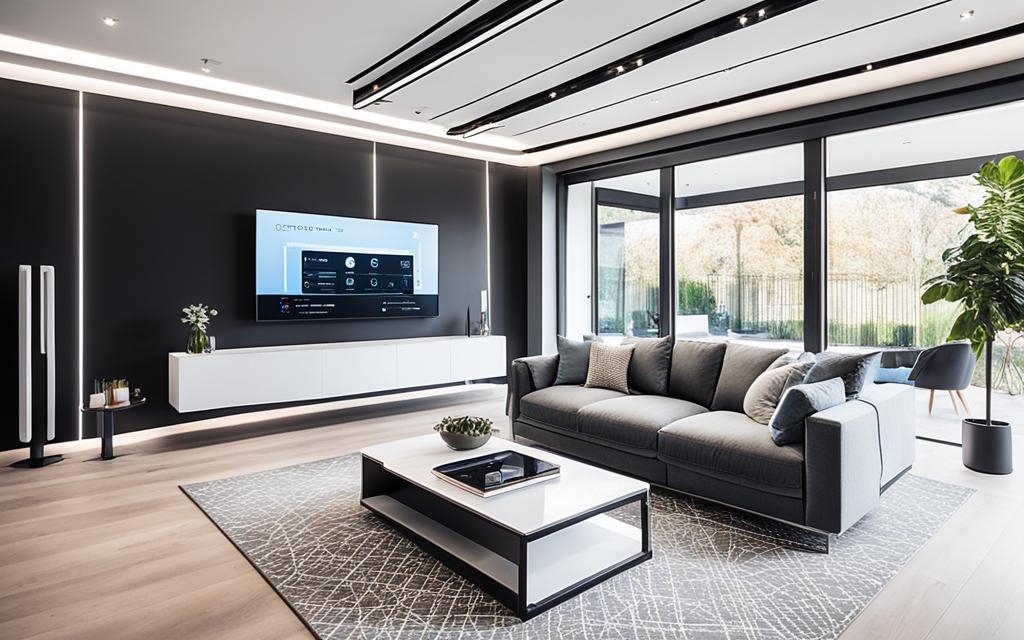
| Advantages of Twisted Pair Cabling Integration | Benefits |
|---|---|
| Secure and Stable Connection | Ensures seamless communication between smart devices and the central control system. |
| High Bandwidth | Enables reliable and fast connectivity for smart devices to work together. |
| Durability | Offers a long-lasting solution for smart home connectivity. |
| Future-Proof | Allows for easy expansion and integration with emerging technologies. |
Exploring Wired and Wireless Smart Home Tech
When it comes to smart home technologies, there are two main types to consider: wired and wireless. Each type offers its unique set of advantages and considerations, making it essential to understand the differences between them. In this section, we will explore wired and wireless smart home tech, highlighting the pros and cons of each.
The Reliability and Performance of Wired Smart Home Tech
Wired technologies, such as CAT 7 twisted pair cabling, provide complete reliability, fast execution, and long lifespans. With a stable and secure connection, wired smart home tech ensures uninterrupted connectivity for all your devices. It offers robust performance, especially in demanding smart home environments, where a strong and reliable connection is crucial.
“Wired smart home technologies offer complete reliability, fast execution, and long lifespans.”
However, it’s important to note that wired smart home tech requires professional installation, which may add to the initial setup costs. Additionally, the physical cabling may limit the flexibility in device placement compared to wireless alternatives.
The Convenience and Flexibility of Wireless Smart Home Tech
Wireless technologies, such as WiFi and Zigbee, offer convenience and flexibility in device placement. They are relatively inexpensive and easy to install, making them accessible for a wide range of homeowners. Wireless smart home tech allows you to connect and control devices without the need for extensive cabling.
“Wireless smart home technologies provide convenience and flexibility in device placement.”
However, wireless tech does have its limitations. Connectivity issues, such as dead spots or interference, can occur in larger homes or areas with thick walls. Moreover, wireless devices may have shorter lifespans and require regular maintenance or battery replacements.
A Comparison of Wired and Wireless Smart Home Tech
To summarize the comparison between wired and wireless smart home tech, let’s take a closer look at their key considerations:
| Wired Smart Home Tech | Wireless Smart Home Tech | |
|---|---|---|
| Reliability | High | Dependent on Signal Strength and Interference |
| Performance | Excellent | Varies based on Signal Strength |
| Installation | Requires Professional | DIY-friendly |
| Device Placement | Limitations due to Cabling | Flexible |
| Cost | Higher Initial Investment | Lower Initial Investment |
By understanding these factors, you can make an informed decision on the right smart home tech for your needs. It’s worth considering a combination of wired and wireless technologies to optimize your smart home setup, utilizing the strengths of both.

Remember, the choice between wired and wireless smart home tech ultimately depends on your specific requirements, budget, and preferences. Consider the reliability, performance, installation process, device placement, and cost implications before making a decision.
Pros and Cons of KNX Wired Technology
When it comes to smart home technologies, KNX Wired Technology is a popular choice for many homeowners. Known for its reliability and fast device execution, KNX offers seamless integration with other KNX-certified devices, providing a holistic smart home experience.
One of the key advantages of KNX Wired Technology is its longevity. Built to last for over 30 years, KNX wiring ensures a stable and reliable connection throughout its lifespan. This makes it a solid and long-term solution for smart home connectivity.
However, there are a few considerations to keep in mind when it comes to KNX Wired Technology. The installation or adaptation of KNX wiring can be costly, requiring the expertise of a certified professional to ensure proper setup and functionality. Additionally, KNX Wired Technology may not offer out-of-the-box smartphone control like some other smart home solutions.
KNX Wired Technology offers complete reliability, fast device execution, and seamless integration with other KNX-certified devices.
Despite these considerations, KNX Wired Technology remains a popular choice for homeowners who prioritize reliability and long-term performance in their smart home systems.
| Pros | Cons |
|---|---|
| Complete reliability | Higher installation/adaptation cost |
| Fast device execution | Requires certified professional for installation |
| Seamless integration with KNX-certified devices | No out-of-the-box smartphone control |
The pros and cons table above summarizes the key advantages and considerations of KNX Wired Technology in smart homes.
Pros and Cons of Wireless Technology for Smart Homes
In the age of advanced technology, wireless technology has become increasingly popular for smart homes. It offers numerous advantages, such as affordability, easy installation, and the convenience of smartphone control. However, like any technology, wireless systems also have their pros and cons that homeowners should consider before making a decision.
Pros of Wireless Technology
- Affordability: Wireless systems are generally more cost-effective compared to their wired counterparts. The absence of wiring and complex installation processes often results in lower overall costs.
- Easy Installation: Setting up a wireless smart home system is relatively simple. Homeowners can install devices themselves without the need for professional assistance.
- Smartphone Control: Wireless technology allows for seamless integration with smartphones, giving homeowners the ability to control various aspects of their smart home remotely.
- Automation: Wireless systems offer the convenience of automating various home functions, such as lighting, security systems, and temperature control.
- Integration with Wireless IoT Devices: Wireless technology easily integrates with a wide range of wireless Internet of Things (IoT) devices, providing a comprehensive and connected smart home experience.
Cons of Wireless Technology
- Shorter Lifespan: Wireless devices generally have a shorter lifespan compared to their wired counterparts. They may require frequent upgrades and replacements, increasing maintenance costs in the long run.
- Reliability: In areas with slow internet connections or congested WiFi networks, wireless systems may experience connectivity issues and sluggish performance.
- Interoperability Limitations: Different manufacturers may use varying wireless protocols, resulting in interoperability issues between devices from different brands.
- Security Concerns: Wireless systems may be susceptible to hacking and unauthorized access if not properly secured. Homeowners should prioritize implementing robust security measures to protect their smart home devices and data.
While wireless technology offers convenience and flexibility, it’s essential to evaluate the specific needs and priorities of your smart home. Consider the reliability of your internet connection, the size of your home, and the level of integration required before making a decision between wireless and wired technology.
“Wireless technology offers convenience and flexibility, but it’s essential to evaluate the specific needs and priorities of your smart home.”
Conclusion
Twisted Pair cabling, specifically CAT 7, plays a vital role in integrating smart home technologies. Its reliability, durability, and high performance make it an essential component for connecting various smart devices in a home. While wired technologies like CAT 7 offer complete reliability, wireless technologies provide affordability and easy installation options.
The choice between wired and wireless technology ultimately depends on the specific needs and priorities of each homeowner. If reliability and performance are top concerns, integrating Twisted Pair cabling, such as CAT 7, ensures a seamless and enhanced smart technology experience. On the other hand, for those seeking affordability and flexibility, wireless technologies like WiFi and Zigbee offer convenient options.
Whether opting for wired or wireless technology, the integration of Twisted Pair cabling in smart home technologies ensures a reliable and efficient connection between various devices. By utilizing CAT 7 cabling, homeowners can enjoy the benefits of a smart home, including automation, security, and convenience.
Integrating Twisted Pair cabling in smart homes not only enhances the connectivity and performance of smart devices but also future-proofs the home for technological advancements. With its superior performance and durability, CAT 7 cabling provides a solid foundation for the construction and expansion of smart homes, ensuring a seamless and integrated living experience.
FAQ
What is the importance of twisted pair cabling in smart homes?
Twisted Pair cabling, specifically CAT 7, plays a crucial role in ensuring reliable connectivity in smart homes. It provides a high-performance connection with a special double shielding and can handle up to 600 MHz. CAT 7 cabling offers higher performance and durability compared to previous generations like CAT 5 and CAT 6, making it a reliable and future-proof option for integrating smart home technologies.
What is the difference between CAT 5, CAT 6, and CAT 7 cabling?
CAT 5 was the first Ethernet cabling used for computer networks but has been deprecated since 2001. CAT 6 introduced more rigorous specifications for crosstalk and system noise, offering performance up to 250 MHz. CAT 7 is a Gigabit Ethernet cable specifically designed for smart homes. It provides performance up to 600 MHz with special double shielding for its twisted pairs, making it more durable and reliable than its predecessors.
What are the advantages of CAT 7 twisted pair cabling for smart homes?
CAT 7 twisted pair cabling offers higher resistance and efficiency compared to CAT 6 and CAT 5, thanks to its cross-section design and double shielding. It is more powerful, resistant, sturdy, and energy-saving. CAT 7 cables have a longer lifespan and can withstand the demands of a smart home environment, ensuring reliable and fast connectivity for smart devices.
How does twisted pair cabling integrate into smart home technologies?
Twisted pair cabling, specifically CAT 7, connects the sensor points in a smart home that control functions like temperature, motion, and audio. It provides a secure and stable connection, ensuring seamless communication between different smart devices and the central control system. Its high bandwidth and durability make it an ideal choice for the construction and expansion of smart homes.
What are the differences between wired and wireless smart home technologies?
Wired technologies, such as CAT 7 twisted pair cabling, offer complete reliability, fast execution, and long lifespans. They provide a stable and secure connection but usually require professional installation. Wireless technologies, like WiFi and Zigbee, are relatively cheap, easy to install, and offer flexibility in device placement. However, they may have connectivity issues, shorter lifespans, and limitations in large installations with multiple devices.
What are the pros and cons of KNX wired technology for smart homes?
KNX wired technology offers complete reliability and fast device execution. It is built to last for over 30 years and provides seamless integration with other KNX-certified devices. However, KNX wiring can be costly to install or adapt, and it requires a certified professional for installation. While it may not offer out-of-the-box smartphone control, it provides a solid and long-term solution for smart home connectivity.
What are the pros and cons of wireless technology for smart homes?
Wireless technology offers advantages like affordability, easy installation, and smartphone control. It allows for automation and integration with a wide range of wireless IoT devices. However, the lifespan of wireless devices is generally shorter, and they may be unreliable in areas with slow internet connections or congested WiFi networks. Interoperability and connectivity issues among different manufacturers’ devices are also limitations of wireless technology in smart homes.
What is the conclusion regarding integrating twisted pair cabling in smart home technologies?
Integrating twisted pair cabling, especially CAT 7, in smart home technologies ensures a reliable and enhanced smart technology experience. It offers reliability, durability, and high performance for connecting various smart devices in a home. The choice between wired and wireless technology depends on the specific needs and priorities of each homeowner. Ultimately, utilizing twisted pair cabling in smart home technologies provides a future-proof and reliable solution for smart home connectivity.

